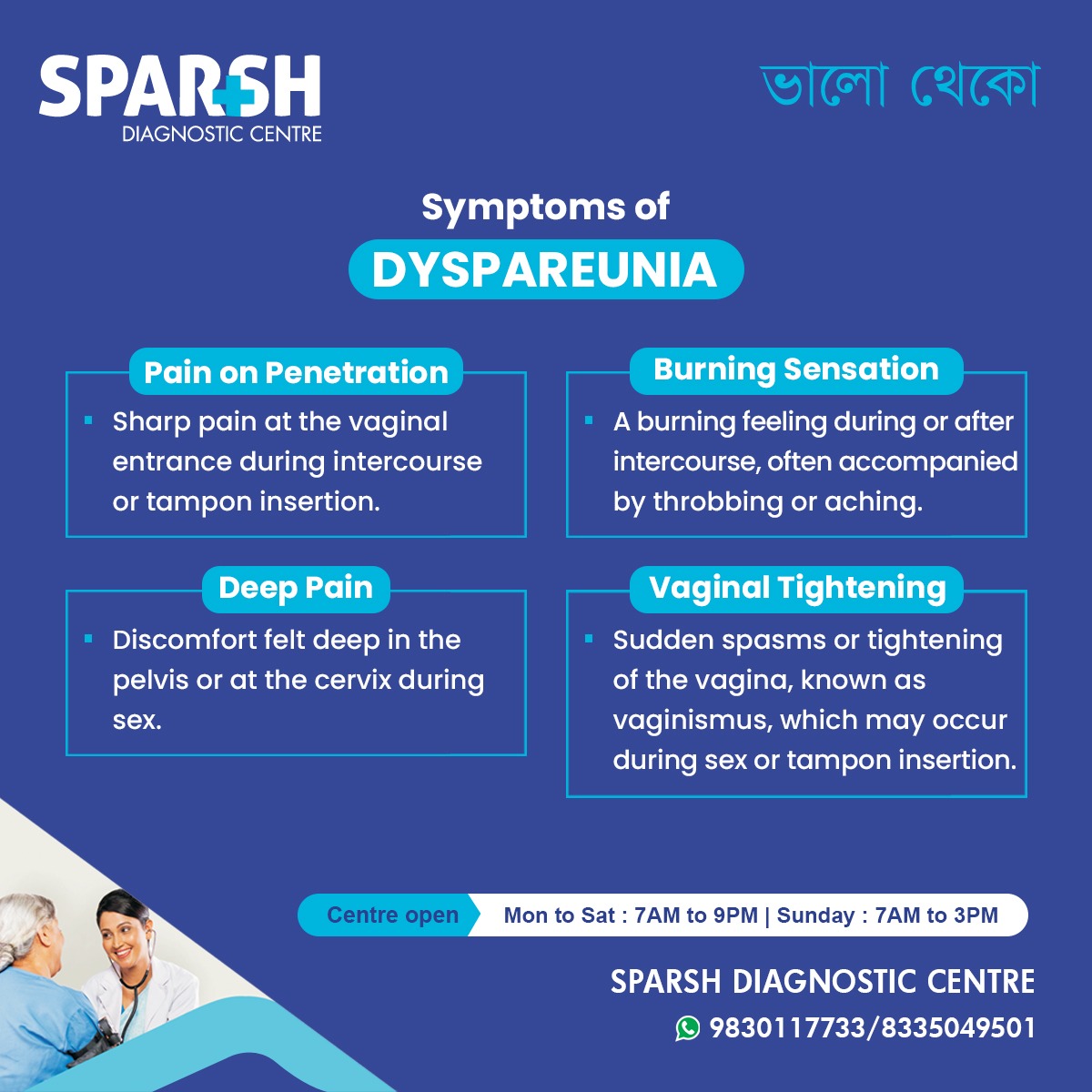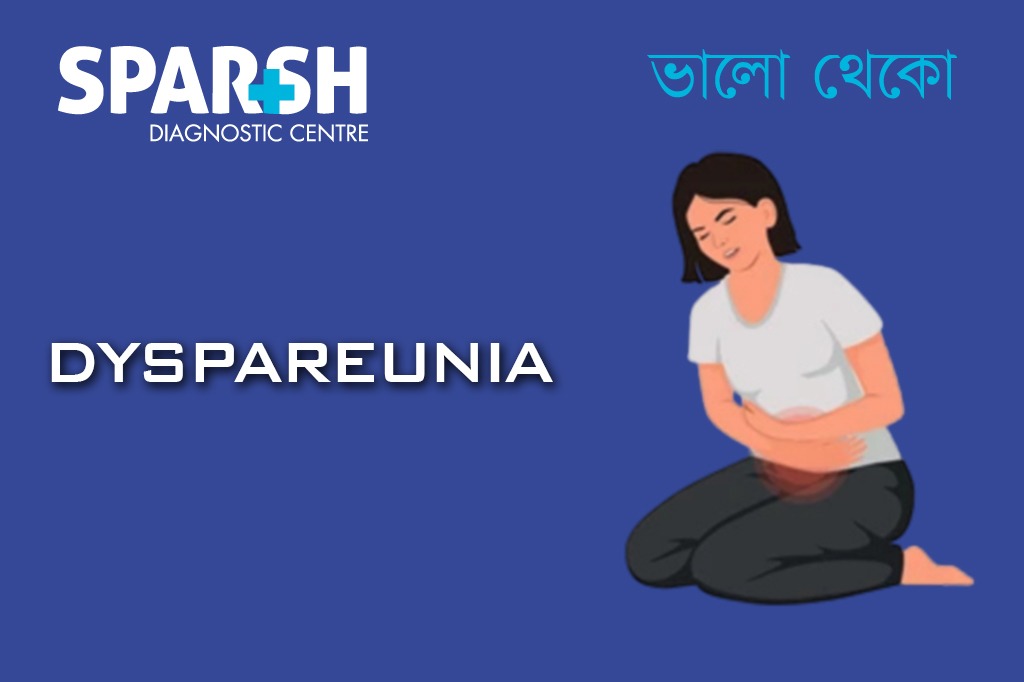Sexual health is a vital aspect of overall well-being. When pain or discomfort occurs during sexual intercourse, it can affect not only physical health but also emotional and relational harmony. One such condition that causes pain during sex is Dyspareunia.
Dyspareunia refers to persistent or recurrent pain in the genital area during or after sexual intercourse. It affects women more commonly but can occur in men as well. This pain can be mild to severe and can occur at the vaginal entrance, deep within the pelvis, or both.
At Sparsh Diagnostic Centre, we aim to help you understand the underlying causes of Dyspareunia, recognize its symptoms, and seek timely diagnosis and treatment.
What is Dyspareunia?
Dyspareunia is a medical term derived from Greek words meaning “painful sexual intercourse.” It involves pain before, during, or after penetration. The pain can have physical, emotional, or psychological causes—or a combination of these.
The condition may be superficial (pain at the vaginal entrance) or deep (pain felt inside the pelvis or lower abdomen). Identifying the location and timing of pain is crucial to finding the root cause and choosing appropriate treatment.
Types of Dyspareunia
Superficial Dyspareunia
Pain occurs at the entrance of the vagina during penetration or tampon insertion.
Common causes include vaginal dryness, infections, or skin irritation.
Deep Dyspareunia
Pain is felt deeper within the pelvis or during deep thrusting.
Often linked to conditions like endometriosis, pelvic inflammatory disease (PID), or uterine fibroids.
Primary Dyspareunia
The pain has been present since a person’s first sexual experience.
Secondary Dyspareunia
Pain develops after a period of pain-free intercourse.
Common Symptoms of Dyspareunia
According to the infographic by Sparsh Diagnostic Centre, the primary symptoms include:
Pain on Penetration
Sharp or stinging pain at the vaginal entrance during intercourse or tampon insertion.Burning Sensation
A burning or throbbing feeling during or after intercourse, often accompanied by soreness.Deep Pain
Discomfort felt deep inside the pelvis or at the cervix during sex.Vaginal Tightening (Vaginismus)
Involuntary tightening or spasms of the vaginal muscles during penetration, causing pain or difficulty with intercourse.

Other associated symptoms may include:
Vaginal dryness or itching
Painful urination after sex
Lower back or pelvic pain
Emotional distress or anxiety during intimacy
Causes of Dyspareunia
Dyspareunia can result from a wide range of physical and psychological factors. Let’s explore the most common causes.
1. Physical Causes
Infections: Vaginal yeast infections, urinary tract infections (UTIs), or sexually transmitted infections (STIs).
Hormonal Changes: Menopause, postpartum period, or use of hormonal contraceptives can reduce vaginal lubrication.
Skin Conditions: Dermatitis, eczema, or lichen sclerosus affecting the vulva.
Endometriosis: A painful disorder where tissue similar to the uterine lining grows outside the uterus.
Pelvic Inflammatory Disease (PID): Infection of the reproductive organs that can lead to deep pelvic pain.
Uterine Fibroids or Ovarian Cysts: Can cause pressure or pain during intercourse.
Vaginal Dryness: Often due to hormonal changes or insufficient arousal.
Episiotomy Scars or Surgery: Post-childbirth scars can make penetration painful.
2. Psychological Causes
Anxiety or Depression: Emotional stress or fear can tighten pelvic muscles.
Sexual Trauma: Past experiences of abuse or negative sexual encounters.
Relationship Problems: Lack of communication or intimacy issues with a partner.
Body Image Issues: Low self-esteem or embarrassment during sex can increase tension.
Often, physical and emotional factors coexist, making diagnosis and treatment more complex.
Risk Factors
Certain factors increase the likelihood of developing Dyspareunia:
Menopause or postpartum hormonal changes
History of pelvic surgery or radiation
Sexual trauma or abuse
Use of certain medications (like antidepressants or antihistamines)
Chronic pelvic conditions (endometriosis, vulvodynia)
Stress or relationship strain
Diagnosis of Dyspareunia
Proper diagnosis requires a comprehensive medical evaluation. At Sparsh Diagnostic Centre, doctors follow a systematic approach:
Detailed Medical History
Discussion about symptoms, pain timing, intensity, and emotional factors.Physical Examination
Inspection of the vulva, vagina, and pelvic area to identify infections, injuries, or abnormalities.Pelvic Exam or Ultrasound
Detects structural causes such as fibroids, cysts, or endometriosis.Laboratory Tests
Tests for infections (UTIs, STIs), hormonal imbalances, or inflammation.Psychological Evaluation
To identify any anxiety, depression, or emotional distress contributing to the pain.
Early diagnosis helps in finding the underlying cause and planning a personalized treatment plan.
Treatment Options for Dyspareunia
Treatment depends on the root cause of the pain. It may involve medical, psychological, or lifestyle-based approaches—or a combination of all.
1. Medical Treatments
Medications:
Antibiotics or antifungal creams for infections
Hormone replacement therapy (HRT) for menopausal dryness
Lubricants or vaginal moisturizers to ease dryness
Topical Estrogen:
Helps restore elasticity and moisture in postmenopausal women.Pain Relief:
Local anesthetic creams or gels may reduce surface pain during intercourse.
2. Physical Therapy
Pelvic Floor Exercises:
Strengthen and relax pelvic muscles to reduce vaginal tightness.Biofeedback Therapy:
Helps control involuntary muscle contractions linked with vaginismus.Vaginal Dilators:
Gradually stretch vaginal muscles to reduce pain and tightness.
3. Psychological Therapy
Counseling or Sex Therapy:
Addresses emotional or relationship-related factors.Cognitive Behavioral Therapy (CBT):
Helps manage anxiety or trauma associated with sexual activity.Couples Therapy:
Improves communication and emotional intimacy.
4. Lifestyle and Self-care Tips
Use water-based lubricants during intercourse.
Engage in longer foreplay to ensure natural lubrication.
Avoid harsh soaps or douches that irritate the vaginal lining.
Practice relaxation techniques such as yoga or meditation.
Maintain open communication with your partner.
Complications if Left Untreated
Ignoring Dyspareunia can lead to several complications, such as:
Chronic pelvic pain
Loss of sexual desire
Relationship issues
Emotional distress or depression
Reduced quality of life
Early consultation with a gynecologist can prevent these complications and help restore confidence and comfort.
When to See a Doctor
You should consult a doctor if:
You experience pain during or after intercourse frequently
Pain persists despite using lubricants
You notice unusual discharge, itching, or bleeding
Pain is accompanied by fever or pelvic discomfort
At Sparsh Diagnostic Centre, our team of gynecologists and diagnostic specialists can help identify the root cause through advanced diagnostic tests and provide personalized care.
Diagnosis and Care at Sparsh Diagnostic Centre
Sparsh Diagnostic Centre offers comprehensive women’s health services, including:
Pelvic ultrasound for uterine and ovarian assessment
Hormone testing for menopausal or thyroid issues
Infection screening for STIs or bacterial vaginosis
Specialized gynecological consultations
Our compassionate approach ensures that patients feel heard, respected, and comfortable throughout the diagnostic process.
Prevention Tips
While not all causes of Dyspareunia are preventable, following these steps can help reduce your risk:
Stay hydrated and maintain vaginal moisture.
Avoid using perfumed or harsh hygiene products.
Treat infections promptly.
Manage stress through relaxation or therapy.
Engage in regular gynecological check-ups.
Living with Dyspareunia
Coping with painful intercourse can be emotionally challenging. Remember — you’re not alone. Many women experience Dyspareunia at some stage in life, and with medical care and emotional support, it can be effectively managed.
Encourage open conversations with your healthcare provider and your partner. Healing often begins with awareness, empathy, and proactive care.
Frequently Asked Questions (FAQs)
1. Is Dyspareunia common?
Yes, Dyspareunia is quite common among women, especially those in menopausal or postpartum phases. It can also occur at any age due to infections or psychological stress.
2. Can men experience Dyspareunia?
While less common, men can experience pain during intercourse due to infections, skin irritation, or psychological stress.
3. Can stress cause Dyspareunia?
Yes. Stress and anxiety can lead to involuntary vaginal muscle tightening, making intercourse painful.
4. What tests help diagnose Dyspareunia?
Tests include pelvic examination, ultrasound, infection screening, and hormone analysis to determine the underlying cause.
5. How can I make intercourse less painful?
Use lubricants, take time for foreplay, and address any infections or emotional issues with your doctor or therapist.
6. Can Dyspareunia be cured completely?
Yes, most cases can be successfully treated once the underlying cause is identified and managed appropriately.
7. Does menopause increase the risk of Dyspareunia?
Yes. Declining estrogen levels during menopause cause vaginal dryness and thinning, increasing the risk of painful intercourse.
Dyspareunia can be distressing, but it’s treatable with the right care and guidance. Addressing both the physical and emotional aspects is key to recovery.
If you or your partner experience pain during intimacy, don’t ignore it. Consult the experts at Sparsh Diagnostic Centre for a thorough evaluation and compassionate care.
📍 Centre Open:
Mon to Sat: 7 AM to 9 PM
Sunday: 7 AM to 3 PM
📞 Contact: 9830117733 / 8335049501
🌐 www.sparshdiagnostica.com
Sparsh Diagnostic Centre — Your Partner in Women’s Health.
#BhaloTheko
Disclaimer:
No content on this site, regardless of date, should ever be used as a substitute for direct medical advice from your doctor or other qualified clinician.

![]()






[…] Causes: Painful intercourse (dyspareunia) might be caused by vaginal atrophy, infections, or structural issues like uterine prolapse. It […]
[…] Pain during intercourse (dyspareunia) […]
[…] Pain during intercourse (Dyspareunia) […]